The notion of keystone species was introduced by zoologist Dr Robert T Paine in the year 1969 to denote an organism that largely affects its environment.
In biological terms, keystone species refer to organisms that can ingrate and explain an entire ecosystem that they consider as their habitat.
It is because these organisms exist in nature can their habituating ecosystem stay healthy and flourishing. Without these organisms, there would be a sudden disbalance in the ecological cycle.
Some keystone species examples include:
- The African elephant
- Tiger Sharks
- Meerkats
- Starfish
- Prairie dogs
- Saguaro cactus
- Grizzly bears
- Grey wolves
- Hummingbirds
- Figs
- Beavers
- Snowshoe hare
- Sea otters
- Bees
- Dolphins
- American alligator
- Cassowary
- Acorn Banksia
- Tigers
- Oak
- Giraffes
- Mangrove trees
- Corals
- Salmon
- Jaguars
- Sugar maple tree
- Krill
- Parrotfish
- Woodpeckers
- Galapagos tortoise
- African termites
- Bats
Next, we will discuss a bit about the above-mentioned examples.
Keystone species examples
African elephant
The largest mammal living on land is also a very vital keystone species. They trample smaller seedlings preventing the grasslands from simply turning into woodlands.
Tiger Sharks
Though most shark species are considered keystone species the tiger shark is well known among these keystone species examples. Found in the Indian Ocean around the coast of Australia, tiger sharks help to maintain the overall health of the ocean.
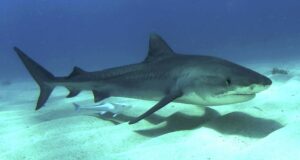
Image: Wikipedia
Meerkats
One of the most important keystone species examples of the Kalahari desert, the meerkats help to control the desert ecosystem. Meerkats are pack animals that devour insects and arachnids and help to maintain a balance between the vegetation and the animals that are dependent on them.
Starfish
Among keystone species examples the sea star species Pisaster ochraceus is a predator of the shallows. Mainly found in the tide fools around the northwestern parts of North America, these are the main predators of a variety of mussels, barnacles and algae that could otherwise go out of control.
Prairie dogs
Contrary to the name the prairie dogs are rodents that are considered very important among the keystone species examples. Prairie dogs are social animals that live together in large groups in underground burrows. This till the soil and the unused burrows provide homes for other animals.
Saguaro cactus
The saguaro cactus is what comes to mind when we think of deserts with their long hands standing like skeletons. These cacti can absorb over 750 litres of water and store it in their flesh. This provided food and hydration to the desert residents. Even after death, the skeletons of these cacti provide shelters for desert birds and animals.
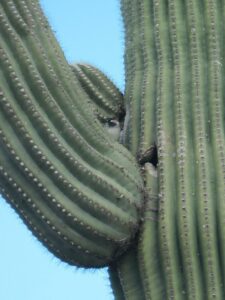
Grizzly bears
Grizzly bears serve a very significant ecological role and are regarded as a keystone species due to the importance of their existence in maintaining a healthy environment. These bears are significant food chain regulators due to their top-down impacts on their primary prey and allied species.
Grey wolves
Wolves play a major role in maintaining a healthy ecosystem by managing prey populations, allowing many other plant and animal species to thrive. In this aspect, wolves set off a chain reaction by “touching” or affecting everything-songbirds, beavers, fish, and butterflies.
Hummingbirds
All hummingbird species are considered essential keystone species examples. Hummingbirds are the chief pollinators for a variety of flowering and fruiting plants and have a more widespread range when compared to insects.
Figs
Fig trees are a major resource in tropical forests throughout the world, yielding fruit that nourishes over 1,200 different varieties of birds, bats, and other creatures all year.
Beavers
Beavers are ecosystem architects who radically alter the physical habitat in which they live by building dams in rivers and small streams. These dams allow smaller animals, amphibians and birds to find shelter and breed in these areas. They also store nutrients in plants and help to prevent floods and also improve water quality.
Snowshoe hare
The snowshoe hare is actually a prey species that sustains animals like the lynx and other predators during the cold Canadian winters in the arboreal forests. It allows the prey and predator balance to exist thereby maintaining the health of the ecosystem so it’s considered a keystone species.
Sea otters
Sea otters are considered a keystone species example as they are one of the most highly rated predators of sea urchins and clams. A sudden incline in sea urchin and clam population could wipe out the kelp or coral beds which provide food and shelter to another host of ocean organisms.
Bees
Bees are probably one of the most significant keystone species examples. They not only pollinate most of the edible crops and other wildflowers and fruits but the honey they produce is also a food source for a number of animals and birds. If bee populations are wiped out a huge number of flora species would end up going extinct as well.
Dolphins
Dolphins play a crucial role in keeping their ecology in balance. They devour other animals, particularly fish and squid, and are a source of food for some sharks and other predators. Without dolphins, the prey animals would become even more abundant, and their predators have far less to eat.
American alligator
The American alligator, being the apex predator in the Everglades, has a significant impact on the environment through interactions with and eating other creatures.
Cassowary
The cassowary is a large flightless bird often referred to as the “gardener of the rainforests”. These large birds are primarily frugivorous i.e. they mainly consume fruits. Hence they allow seed dispersal across the rainforest allowing the plants to grow in a larger range of the rainforests.
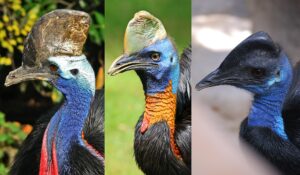
Image: Wikipedia
Acorn Banksia
Something between a shrub or a tree and native to Western Australia the Acorn Banksia is another important food resource and an important keystone species example. This acorn-like plant is the sole food source for honeyeaters, an indigenous bird species, in this region and a specific period each year.
Tigers
Be it in the Sunderbans or the Siberian pine forests the tiger is the largest predator in these areas. They usually keep the larger prey population in control so that the vegetation is just not swept off by them.
Oak
The live oak is a keystone species example that acts as the ecosystem’s backbone. It provides shade and a home for hundreds of living organisms such as animals, birds, insects, and other plants.
Giraffes
Giraffes, as a keystone species, maintain the trees in Africa’s savannahs trimmed, much like landscapers. They travel around a lot in quest of food because they devour nearly twice their body weight in vegetation. They disseminate seeds from the plants they eat as they roam from one location to the next.
Mangrove trees
Be it the deltas of the Sundarbans or the Florida everglades, mangroves are essential keystone species examples of the coastal areas. They are called the kidneys of the coast, allowing filtering of water to provide habitat and food for the organisms of the area. They also hold the soil and prevent erosion due to the daily diurnal tides.
Corals
Corals are probably the most significant keystone species examples of the ocean. Coral reefs are indicators of the health and pollution levels of our ocean water. They also provide shelter to a variety of fish, molluscs mammals and even sharks.
Salmon
Salmon have a huge impact on both the terrestrial and aquatic ecosystems and the organisms residing in them. More than 40 vertebrate species, including salmon, trout, birds, and mammals, benefit directly from yearly salmon migrations by eating these salmon, their eggs, carcasses, or fry.
Jaguars
Jaguars are top predators, which means that nothing in their environment preys on them. They are included as a keystone species example because they help keep prey populations in check.
Sugar maple tree
The symbol of the nation of Canada the Sugar maple is another well-known keystone species example. Because the Sugar Maple offers a lot of leaf litter that earthworms can feed on, it creates a varied range of species, such as the earthworm population.
Krill
Krill are the smallest predators of the ocean grazing on zooplankton and phytoplankton. Plankton in general contains a lot of essential nutrients that float in the ocean freely. Once larger predators like whales or whale sharks consume these krill the nutrients in turn get transferred to them.
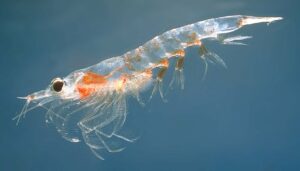
Image: Wikipedia
Parrotfish
Parrotfish are important to many coral reefs because they eat seaweed, also known as macroalgae. This microalga is also seen in aquariums which would otherwise suffocate corals and kill them. Hence they are considered a keystone species example in some areas of the globe.
Woodpeckers
Across the world, the woodpeckers are considered as essential engineers of their ecosystem. Woodpeckers carve up holes in the trees to make hollows to search for insects and larva and also for nesting. A lot of these abandoned holes help to provide shelter to a large number of smaller woodland animals and birds.
Galapagos tortoise
Indigenous to the Galapagos archipelago, these giant tortoises are an important keystone species example. They are grazers that keep the vegetation in check, and help in seed dispersal and tilling of the land.
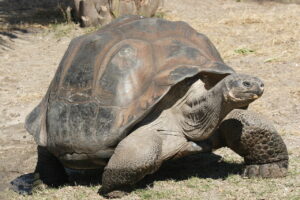
African termites
Though not the most conventional among the keystone species examples, the African termites are important to the ecosystem of the arid areas of the continent. They build nests that can reach up to 30 meters in height thereby tilling the land, and providing nutrition to the plants and vegetation growing in the area.
Bats
Most of the 1390 species of bats are considered keystone species examples probably due to their diverse diet and habitat range. For example, the baobab tree of Africa solely depends on the baobab tree bat for pollination.
Also Read:
- Elbow anatomy
- Do fungi have ribosomes
- Does bacteria have vacuole
- Silverfish types
- Hand anatomy
- Filamentous bacteria examples
- Are bacteria photosynthetic
- Chromosome function in plant cell
- Food vacuole in plant cell
- Does nucleus have chromosomes

I am Trisha Dey, a postgraduate in Bioinformatics. I pursued my graduate degree in Biochemistry. I love reading .I also have a passion for learning new languages.
Let’s connect through linked in: